WEBSITE HIGHLIGHTS: SEARCH OUR WEBSITE
![]() With the hundreds of pages of information at www.DiamondSourceVA.com it is sometimes difficult to find the information available on a specific topic. We provide a search box above the menu on the left side of each page that produces search results for the web site on any word or phrase you enter.
With the hundreds of pages of information at www.DiamondSourceVA.com it is sometimes difficult to find the information available on a specific topic. We provide a search box above the menu on the left side of each page that produces search results for the web site on any word or phrase you enter.
If you have a particular question and are looking for an answer, put the keywords of your question in the search box and see if we have already addressed that issue. If you have a question that we have not discussed, please call or email us so we can add that information for you and future shoppers.
DIAMOND SHOPPER MISTAKES: BEWARE UNBELIEVABLE BARGAINS
If it sounds too good to be true, it probably is.
Take time to do your homework when diamond shopping just as you should with any important purchase. Yet the diamond and jewelry industry has a long history of pushing emotional buttons to make the sale. To keep your emotions in check, learn what to look for and be sure to ask questions.
With the online resources at your finger tips today, it is easier than ever before to make better decision about your diamond purchase. Yet shoppers fall prey every day to “unbelievable bargains” offered by jewelers, eBay auctions and newspaper ads.
 Several times a month we have clients say they have purchased a diamond for prices lower than ours. When we ask what they purchase, often the price they quote is hundreds and sometimes thousands of dollars less than our cost on the wholesale market. When we ask if they have the certification or had the diamond independently examined, they often say respond that they got papers with the diamond saying it was appraised for thousands of dollars more than they paid for it. The questions we often pose is why they think that retailer was willing to sell them a diamond for hundreds or thousands of dollars less than they could sell it to us.
Several times a month we have clients say they have purchased a diamond for prices lower than ours. When we ask what they purchase, often the price they quote is hundreds and sometimes thousands of dollars less than our cost on the wholesale market. When we ask if they have the certification or had the diamond independently examined, they often say respond that they got papers with the diamond saying it was appraised for thousands of dollars more than they paid for it. The questions we often pose is why they think that retailer was willing to sell them a diamond for hundreds or thousands of dollars less than they could sell it to us.
Remember: Diamond retailers do not give away their goods. Jewelry store, pawn shops and anyone else in the industry knows what diamonds should sell for. It is the consumer that is usually in the dark, unless they have educated themselves enough to recognize a realistic bargain. While some shoppers think they got a real steal, the truth is the only steal was what happened to their money.
If you are buying a diamond for a fraction of the wholesale price, you are probably not getting the quality advertised. It is common practice for some stores to exaggerate color and clarity grades so shoppers need to protect themselves with a GIA or AGS certification. In the worst case, you run the danger of buying stolen goods. If this is the case and your diamond is identified as stolen goods, you loose the diamond with no compensation.
The bottom line is that serious diamond shoppers need to do their research and use more common sense and less impulse emotions. The Education and Shopping Advice at www.DiamondSourceVA.com provide an excellent place to start.
HIGH PRESSURE HIGH TEMPERATURE TREATMENT (HPHT)
This month we had a client ask if we sold Bellataire brand of diamonds. I asked if she understood that those diamonds are treated to change color. She said yes but that she was still interested because they seem to allow her to purchase D color and high clarity at a lower price than “natural” diamonds. Since I had not heard much about these diamonds for several years, I thought it would make a good topic for this newsletter.
High Pressure High Temperature (HPHT) treatment was first used to change the color of diamonds in the 1970’s when laboratories were able to use high pressure and temperatures above 1900° C to turn change diamond colors to fancy yellow and green colors. Then in early 1999, General Electric (GE) and Lazare Kaplan International (LKI) introduced High Pressure-High Temperature (HPHT) diamonds to the marketplace, initially sold under the name “GE POL,” and more recently as “Bellataire.” This treatment transformed inexpensive brown diamonds into colorless diamonds.
On their Bellataire web site, GE states:
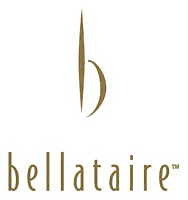 “BELLATAIRE Diamonds are extremely rare Type IIa diamonds that were originally crystallized without color and were destined to become extraordinary gems. During their journey to the surface of the Earth through volcanic pipes, though, these crystals were subjected to intense heat, tremendous pressure, and explosive turbulence. These conditions caused some molecular misalignment in these crystals, resulting in a brownish color and internal stress. The GE process simply provides comparable conditions of heat and pressure, allowing these crystals to spontaneously relieve themselves of their molecular stress and return to their proper alignment and their original colorless state. It is this process of restoration that leads to the description of BELLATAIRE Diamonds as “The Diamond Nature Intended”. GE’s position is that the process they use restores diamonds to their colorless state.
“BELLATAIRE Diamonds are extremely rare Type IIa diamonds that were originally crystallized without color and were destined to become extraordinary gems. During their journey to the surface of the Earth through volcanic pipes, though, these crystals were subjected to intense heat, tremendous pressure, and explosive turbulence. These conditions caused some molecular misalignment in these crystals, resulting in a brownish color and internal stress. The GE process simply provides comparable conditions of heat and pressure, allowing these crystals to spontaneously relieve themselves of their molecular stress and return to their proper alignment and their original colorless state. It is this process of restoration that leads to the description of BELLATAIRE Diamonds as “The Diamond Nature Intended”. GE’s position is that the process they use restores diamonds to their colorless state.
The controversy arises because HTPT diamonds are not easy to detect. It takes specialized skills and equipment to detect diamonds treated by the HPHT process. Gemological Institute of America (GIA) grading reports now indicate when HTPT treatments are detected by stating “HPHT Annealed” or “Artificially Irradiated” in the Origins portion of a report. Grading labs continue their efforts to perfect ways to detect the always-improving process so that consumers can receive full disclosure about the diamonds they purchase.
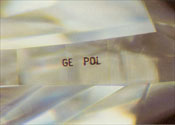 The main producer, GE, uses a registration number and the letters “GE POL” to inscribe their diamonds. Only diamonds that are laser-inscribed with the words “HPHT PROCESSED,” “IRRADIATED,” or a specific registered name are graded by the GIA.
The main producer, GE, uses a registration number and the letters “GE POL” to inscribe their diamonds. Only diamonds that are laser-inscribed with the words “HPHT PROCESSED,” “IRRADIATED,” or a specific registered name are graded by the GIA.
While these laser inscriptions can be polished off, the greater problem is that now there are more companies using the HPHT treatment to color diamonds and not all sellers provide full disclosure.
Should you purchase an HPHT diamond? You’re the only one who can make that decision. The diamonds are definitely gorgeous, but choosing between altered and natural is a very personal decision. Here are few facts about HPHT Diamonds that should be considered:
HPHT is permanent however there is research that indicates that treated diamonds might not be as resistant to abrasions and chipping as untreated diamonds.
 The Federal Trade Commission (FTC) requires that HPHT be disclosed but with detection so difficult, there is a great reliance on laser inscriptions for identification and disclosure.
The Federal Trade Commission (FTC) requires that HPHT be disclosed but with detection so difficult, there is a great reliance on laser inscriptions for identification and disclosure.
HPHT diamonds should cost less than similar natural diamonds. The producers can make big profits because they use very low priced diamonds and transform them into diamonds with much higher and more expensive color grades.
Treated diamonds are difficult to sell because there are relatively few buyers. The demand is for untreated diamonds.
As more companies produce HPHT diamonds, prices could decrease for treated diamonds as opposed to the rising prices for untreated diamonds, making untreated the far better choice from an investment standpoint.
SPRING CUT DIAMONDS
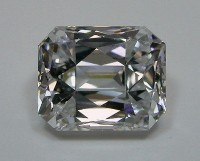 The Spring Cut is patented cut comprised of elements from both the emerald and radiant cuts. M&M Diamond Imports, inventors of Spring Cut diamonds, wanted to create a cut that combined the fire and scintillation of the radiant cut and the elegance of the emerald cut.
The Spring Cut is patented cut comprised of elements from both the emerald and radiant cuts. M&M Diamond Imports, inventors of Spring Cut diamonds, wanted to create a cut that combined the fire and scintillation of the radiant cut and the elegance of the emerald cut.
Emerald cuts are distinctive and beautiful, though understated, because the cut lacks fire. Radiant cuts were developed to remedy the lack of fire in square cuts, but have always been difficult to match, because slight differences in the depth percentage of the stones caused one stone next to another one to look totally different. In devising the new cut, M&M attempted to bring in the best of both worlds by marrying the finer points of emerald cuts and radiant cuts. The beautiful results of their efforts are Spring Cut diamonds.
Because of its style, the Spring Cut tends to look a bit bigger than comparable stones by weight. The SpringCut has 60 facets (there are 47 in a comparable emerald cut). Spring Cut diamonds are accompanied by a certificate of authenticity as well as a certificate by a major gemological laboratory. All SpringCut™ diamonds of more than 40 points are laser inscribed with a SPRINGCUT™ brand and lab-certified number to highlight their individuality. These laser inscriptions help to ensure the authentic high quality cut of this patented diamond shape.
Learn more about the Spring Cut: Click Here
DIAMONDS: SUPPLY AND DEMAND
The world’s biggest diamond producer De Beers recently stated it expected full year 2005 diamond output in terms of carats to increase 7-8 percent from last year.
“That 23 percent (increase in first half) is not going to be repeated in the second half. I project for the year as a whole we should be some 7 to 8 percent ahead of production for 2004 as a whole,” Managing Director Gary Ralfe told industry analysts in a conference call.
De Beers had said group production for the first half was 23.7 million carats, an increase of 23 percent over the same period in 2004.
Meanwhile, the group posted an 8 percent rise in first-half rough diamond sales, helped by higher prices and buoyant demand, but said it planned no more price hikes until later in the year to cut stockpiles.
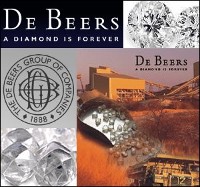 Based in London, the Diamond Trading Company (DTC) is the rough diamond sales arm of the De Beers Group. It sources its rough diamonds from De Beers own Group of mines in Africa, and through agreements with other mining companies. The DTC currently sorts and values about two thirds of the world’s annual supply of rough diamonds by value.
Based in London, the Diamond Trading Company (DTC) is the rough diamond sales arm of the De Beers Group. It sources its rough diamonds from De Beers own Group of mines in Africa, and through agreements with other mining companies. The DTC currently sorts and values about two thirds of the world’s annual supply of rough diamonds by value.
The DTC says it will boost worldwide demand for diamonds by continuing its aggressive marketing efforts. De Beers’ target is to raise growth in demand to around 5 percent annually from an average of 3.2 percent per annum over the past five years.
INCLUSIONS & BLEMISHES: BRUISE
A bruise is a tiny area of impact accompanied by small root-like feathers (like a cracked windshield) visible at 10X magnification. When viewed through an opposing facet, a bruise appears cottony in texture as it radiates into the diamond.
A bruise is sometimes called a percussion mark and is cause by a hard blow to the surface, often on a facet edge, girdle or culet. Diamonds that have been worn for many decades, like Old Miners and Old European cuts, often have bruises on the facet lines of the table where the diamond has been taken many hits over the years. These white blemishes are the tell tale sign of a blow to the diamond that has perhaps not resulted in a chip, but is actually a crumbling of the diamond’s surface.
TAKING CARE OF YOUR DIAMOND WHEN TRAVELING
We recently had a client as the following question:
 I had a question concerning the care of Jennifer’s diamond ring. Since we are traveling abroad for the honeymoon, should she take care to avoid salt water or pool water with chlorine when it comes to the diamond? She is planning to take her cleaning solution that she normally uses to clean the ring but do you have any suggestions on chemically treated pools or otherwise now that we have these beautiful investments? I would greatly appreciate any suggestions you have in caring for her diamonds.
I had a question concerning the care of Jennifer’s diamond ring. Since we are traveling abroad for the honeymoon, should she take care to avoid salt water or pool water with chlorine when it comes to the diamond? She is planning to take her cleaning solution that she normally uses to clean the ring but do you have any suggestions on chemically treated pools or otherwise now that we have these beautiful investments? I would greatly appreciate any suggestions you have in caring for her diamonds.
Here was our response:
Here are some thoughts about caring for your ring while traveling:
- Be sure your insurance covers the ring while out of the country. Most policies do but some do not and you don’t want to find out yours does not after you file a claim.
- Chemicals will not hurt the diamond but can be hard on the metal. The only way you can really protect the ring is to not wear it in the water but that has a risk too if you leave it in the room.
- Another danger around beaches and swimming pools is the rough surfaces. While only diamond can scratch a diamond, sand and concrete can easily scratch metal in a ring.
 I would be more concerned with theft than problems with chemicals or sand which would be minor. While there are some risks of wearing the diamond around those elements, there is also a risk of leaving the ring in the room. Tourists are targets for theft whether it is stealing from your room while the room is being cleaned or while you are walking the street in an area that is not safe.
I would be more concerned with theft than problems with chemicals or sand which would be minor. While there are some risks of wearing the diamond around those elements, there is also a risk of leaving the ring in the room. Tourists are targets for theft whether it is stealing from your room while the room is being cleaned or while you are walking the street in an area that is not safe.
Probably the most important of these points is the first. You want to enjoy your ring and not worry about it. Being careful is one thing, but you don’t need to worry. The purpose of insurance is to protect you from the very unlikely events but you just need to ensure that your coverage applies when you are out of the country.
Discover more about how to take care of your diamonds.
GEMSTONES: TOPAZ
 Topaz comes in a wide range of colors, from colorless to blues, reds and purples, including the shades of brown that many consumers recognize. Topaz is usually named for its color, such as blue topaz or pink topaz and its most valuable color is a golden orange-yellow, called “imperial topaz”.
Topaz comes in a wide range of colors, from colorless to blues, reds and purples, including the shades of brown that many consumers recognize. Topaz is usually named for its color, such as blue topaz or pink topaz and its most valuable color is a golden orange-yellow, called “imperial topaz”.
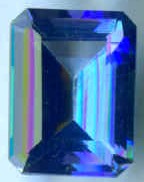 Topaz is commonly thought of as a sky-blue gem, but it was not until this century that blue topaz became widespread on the gem market. Natural blue topaz with a deep hue is very uncommon in nature; colorless to light hued stones are heat-treated to achieve the blue color. Likewise, topaz rarely occurs naturally in pink; virtually all pink topaz is heat treated from yellow or brownish material. Topaz sometimes has the amber gold of fine cognac or the blush of a peach and all the beautiful warm browns and oranges in between.
Topaz is commonly thought of as a sky-blue gem, but it was not until this century that blue topaz became widespread on the gem market. Natural blue topaz with a deep hue is very uncommon in nature; colorless to light hued stones are heat-treated to achieve the blue color. Likewise, topaz rarely occurs naturally in pink; virtually all pink topaz is heat treated from yellow or brownish material. Topaz sometimes has the amber gold of fine cognac or the blush of a peach and all the beautiful warm browns and oranges in between.
Special trade names include imperial topaz, an expensive variety in shades of medium reddish orange to orange-red, and sherry topaz, with its yellowish brown or brownish yellow to orange shades. Consumers sometimes confuse Citrine or smoky quartz with topaz; the name itself probably comes from the old Greek name Topazios (now Zabargad), a Red Sea island which once produced Peridot, which was mistaken for topaz.
Topaz varieties can come in very generous carat sizes as demonstrated by the Smithsonian Institution’s “American Golden,” a light yellow topaz that’s a mammoth 22,982 carats.
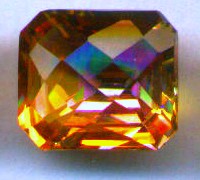 The deposits of topaz are found in the regions of Russia, Siberia, Brazil, Sri Lanka, Africa and China, Japan, Pakistan, Myanmar, Nigeria, Australia, Mexico, and in the United States.
The deposits of topaz are found in the regions of Russia, Siberia, Brazil, Sri Lanka, Africa and China, Japan, Pakistan, Myanmar, Nigeria, Australia, Mexico, and in the United States.
The Egyptians said that topaz was colored with the golden glow of the mighty sun god Ra. This made topaz a very powerful amulet that protected the faithful against harm. The Romans associated topaz with Jupiter, who also is the god of the sun. Some rare and exceptional topaz colors are pale pink to a sherry red.
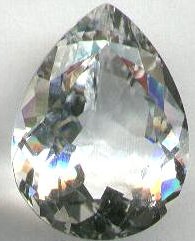 The ancient Greeks believed that it had the power to increase strength and make its wearer invisible in times of emergency. Topaz was also said to change color in the presence of poisoned food or drink. Its mystical curative powers waxed and waned with the phases of the moon: it was said to cure insomnia, asthma, and hemorrhages.
The ancient Greeks believed that it had the power to increase strength and make its wearer invisible in times of emergency. Topaz was also said to change color in the presence of poisoned food or drink. Its mystical curative powers waxed and waned with the phases of the moon: it was said to cure insomnia, asthma, and hemorrhages.
Perhaps the most famous topaz is a large specimen set in the Portuguese Crown, the Braganza, which was first thought to be a diamond. There is also a beautiful topaz set in the Green Vault in Dresden, one of the world’s important gem collections.
Topaz is a very hard gemstone but it can be split with a single blow, a trait it shares with diamond. As a result it should be protected from hard knocks.
Topaz is the birthstone for those born in the month of November.
